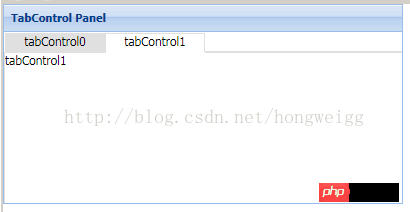Heim >Web-Frontend >js-Tutorial >Vollständiger Code für die Entwicklung von Javascript-EXTJS-Komponenten
Vollständiger Code für die Entwicklung von Javascript-EXTJS-Komponenten
- 黄舟Original
- 2017-03-18 15:03:091855Durchsuche
Ziel: EXTJS-Komponentenentwicklung, Implementierung einer TABSteuerung aus der Komponentenbasis.
Verwendung von EXTJS Version 5.0. Test bestanden.
Dieses Beispiel ist immer noch sehr einfach und veranschaulicht anhand von Beispielen lediglich eine Grundidee der Verwendung von EXTJS für die Komponentenentwicklung.
<html>
<head>
<meta http-equiv="Content-Type" content="text/html; charset=gb2312">
<title>EXT JS TEST</title>
<link rel="stylesheet" type="text/css" href="extjs/resources/ext-theme-classic-all.css" />
<script type="text/javascript" src="extjs/ext-all.js"></script>
<style>
.tabsp{
width:500px;height:450px;
margin-top: 0px; margin-left: 0px;
}
.tabsp ul{
width: 500px;height: 20px;
list-style: none;
margin-bottom: 0px;margin: 0px;
padding: 0px;
border-left:solid 1px #ffffff;border-right:solid 1px #ffffff;border-top:solid 1px #ffffff;border-bottom:solid 1px #e0e0e0;
}
.tabsp p{
width: 500px;height: 330px;
background-color: #ffffff;
border:solid 1px #e0e0e0;
}
.tabsSelectedLi{
width: 100px;height: 20px;
background-color: white;
float: left;
text-align: center;
border-left:solid 1px #e0e0e0;border-right:solid 1px #e0e0e0;border-top:solid 1px #e0e0e0;border-bottom:solid 1px #ffffff;
cursor:default;
}
.tabsUnSelectedLi{
width: 100px;height: 20px;
background-color: #e0e0e0;
float: left;
text-align: center;
border:solid 1px #e0e0e0;
cursor:default;
}
</style>
</head>
<body>
<script lang="javascript">
//引入面板类
Ext.require('Ext.panel.Panel');
//定义组件
Ext.define('Ext.ux.TabControl', {
extend: 'Ext.Component', // subclass Ext.Component
alias: 'widget.managedTabs', // this component will have an xtype of 'managedTabs'
renderTpl:'<p id="mytabs" class="tabsp"><ul></ul></p>',
// Add custom processing to the onRender phase.
onRender: function () {
this.callParent(arguments);
this.init();
},
//最后选中项
lastSelectedIndex:0,
//获取选中TAB头的索引
getSelectedIndex: function(selectObj){
var extLis = this.el.query("p>ul>li");
for(var i=0;i<extLis.length;i++){
if(extLis[i] == selectObj){
return i;
}
}
},
init :function(){
var me = this;
for(var i=0;i<2;i++){
this.insertPage(i-1,'tabControl'+i);
}
var extLis = this.el.query("p>ul>li");
for(var i=0;i<extLis.length;i++){
extLis[i].onclick = function(){
var idx = me.getSelectedIndex(this);
me.selectPage(idx);
}
}
},
//选中某页
selectPage: function(idx){
var extUl = this.el.query("p>ul>li");
extUl[this.lastSelectedIndex].className = "tabsUnSelectedLi";
extUl[idx].className = "tabsSelectedLi";
var extp = this.el.query("ul~p");
extp[this.lastSelectedIndex].style.display = "none";
extp[idx].style.display = "block";
this.lastSelectedIndex = idx;
},
//插入页
insertPage: function(idx, title){
//var extEl = this.el.query("p:first-child");
var extLi = this.el.query("ul>li");
if(extLi.length<1){
var extUl = this.el.query("p>ul");
Ext.DomHelper.insertFirst(extUl[0], '<li class="tabsUnSelectedLi">' + title + '</li>');
}else{
Ext.DomHelper.insertAfter(extLi[idx], '<li class="tabsUnSelectedLi">' + title + '</li>');
}
var extp = this.el.query("ul~p");
var extUl = this.el.query("ul");
Ext.DomHelper.insertAfter(extp[idx] || extUl[0], '<p>'+ title + '</p>');
}
});
Ext.onReady(function () {
var tab = Ext.create('Ext.ux.TabControl');
Ext.create('Ext.panel.Panel', {
header:true,
title: 'TabControl Panel',
height: 200,
width: 400,
renderTo: Ext.getBody(),
items: tab
})
tab.selectPage(1);
});
</script>
</body>
</html>Der Endeffekt ist wie folgt:

Das obige ist der detaillierte Inhalt vonVollständiger Code für die Entwicklung von Javascript-EXTJS-Komponenten. Für weitere Informationen folgen Sie bitte anderen verwandten Artikeln auf der PHP chinesischen Website!
Stellungnahme:
Der Inhalt dieses Artikels wird freiwillig von Internetnutzern beigesteuert und das Urheberrecht liegt beim ursprünglichen Autor. Diese Website übernimmt keine entsprechende rechtliche Verantwortung. Wenn Sie Inhalte finden, bei denen der Verdacht eines Plagiats oder einer Rechtsverletzung besteht, wenden Sie sich bitte an admin@php.cn
Vorheriger Artikel:Ausführliche Erläuterung vollständiger Beispiele der Komponentenentwicklung mit jQueryNächster Artikel:Ausführliche Erläuterung vollständiger Beispiele der Komponentenentwicklung mit jQuery
In Verbindung stehende Artikel
Mehr sehen- Eine eingehende Analyse der Bootstrap-Listengruppenkomponente
- Detaillierte Erläuterung des JavaScript-Funktions-Curryings
- Vollständiges Beispiel für die Generierung von JS-Passwörtern und die Erkennung der Stärke (mit Download des Demo-Quellcodes)
- Angularjs integriert WeChat UI (weui)
- Wie man mit JavaScript schnell zwischen traditionellem Chinesisch und vereinfachtem Chinesisch wechselt und wie Websites den Wechsel zwischen vereinfachtem und traditionellem Chinesisch unterstützen – Javascript-Kenntnisse

